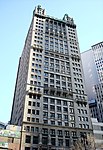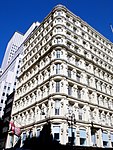St. Paul Building

The St. Paul Building was a skyscraper in the Financial District of lower Manhattan in New York City at 220 Broadway, at the southeast corner of Broadway's intersection with Ann Street. Designed by George B. Post and completed in 1898, it was one of the tallest skyscrapers in New York City upon its completion, at 26 stories and 315 feet (96 m). The facade, cantilevered from the superstructure, contained several sets of double-height Ionic-style colonnades, as well as a group of three sculptures designed by Karl Bitter. The foundations were dug to the level of the underlying sand due to the depth of the bedrock below. The superstructure was designed to allow easy identification and replacement of the beams. The building was occupied mostly by offices, with six elevators inside. The building site was purchased by the Havemeyer family in 1895. The St. Paul Building was named after St. Paul's Chapel, directly across Broadway to the west. It remained in the possession of the Havemeyer family until 1943, when it was sold to Webb and Knapp and then to Chase Bank. The St. Paul Building was demolished in 1958 in order to make way for the Western Electric Building. A part of the facade, including Bitter's sculptures, remains extant at Holliday Park in Indianapolis.
Excerpt from the Wikipedia article St. Paul Building (License: CC BY-SA 3.0, Authors, Images).St. Paul Building
Broadway, New York Manhattan
Geographical coordinates (GPS) Address External links Nearby Places Show on map
Geographical coordinates (GPS)
| Latitude | Longitude |
|---|---|
| N 40.711111111111 ° | E -74.008611111111 ° |
Address
222 Broadway
Broadway 222
10023 New York, Manhattan
New York, United States
Open on Google Maps










